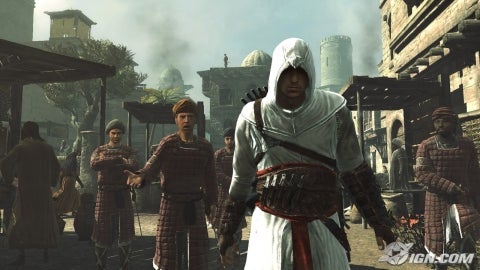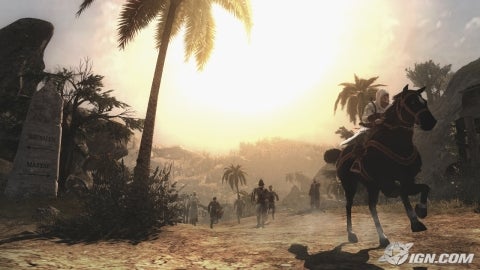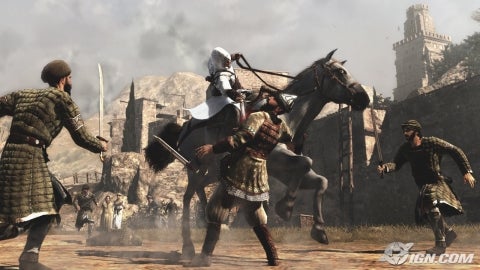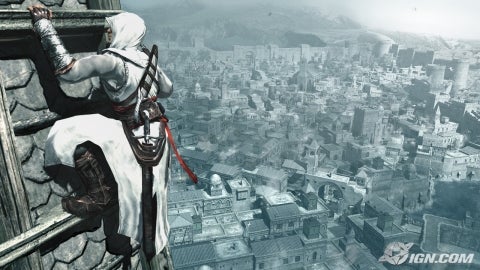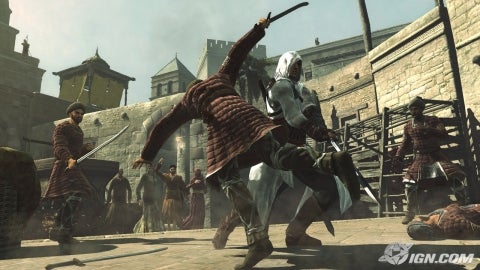This Game is fucking amazing and I WANT IT
September 19, 2007 - Forget what you think you know about Assassin's Creed.
Sure, that's an extremely strong statement to make, particularly if you've been following the game as closely as we have. The upcoming action title, which features an assassin named Altair during the Third Crusade, has been a heavily anticipated action title ever since it made its first debut two years ago. Even the latest demo that we were shown at this year's E3 generated greater buzz, as players tracked down and killed a slave trader. But as we found when we checked out the latest build of the title, Assassin's Creed is much more than killing influential people, climbing buildings and making stealthy escapes into crowds. In fact, Assassin's Creed is designed to be much more of a sandbox-like experience, giving you the freedom to explore and complete missions whenever and however you want. We went to Montreal to check out the latest build, which was going to be shown on the floor at TGS, and found out just how malleable our explorations as an assassin would be.
In the two months since E3 2007, the design team at Ubisoft Montreal has finished the entire game, polishing many more visual details and tightening up the presentation of the title. That might be a bit hard to believe for some, considering how impressive the demo was at E3, but Patrice Desilets, Creative Director on Assassin's Creed, pointed out that the team had included new sound and visual effects, vocal work and additional story details to help flesh out the gameplay. We actually experienced part of this, as we were shown a mission that took place midway through the game where Altair was tasked with assassinating Monfferat, Richard the Lionheart's governor in the rich district of Acre.
As Altair moved through a town square towards a city wall, the game took over and started playing an in-game cinematic. It was still possible to move your way through the assorted crowd members so you could get closer and overhear the heated conversation between the governor and the monarch, but there was another way to experience the scene. Every now and then, the screen would "glitch," displaying a burst of hydrocarbon rings and other chemical model details. By hitting a button during these "glitches," players could switch their camera angles, getting a new perspective on the scene they were watching. We found this could also be applied during the cutscene that followed an assassination, as we watched Monfferat explain his actions to Altair in some striking dissolves and camera transitions as he lay dying.
Elements like this are much more than simply visual tricks or impressive storytelling conceits; a large amount of Assassin's Creed missions will revolve around four separate game phases. The first one will be the acquiring of the initial target, which will involve going to an Assassin's Guild, getting the initial details of who you are tasked with killing and why this person needs to be "pacified." The second phase involves investigation, where players will go around the various districts that they happen to be in, gathering details that they can use to aid them in their goal. The third phase, of course, is the infiltration of a specific location and assassination of your target by whatever means you feel are necessary. Finally, the fourth phase is the escape from the scene of the crime and return to safety at the Assassin's Guild, which allows you to progress further in the game.
We were somewhat surprised that there would be an investigatory phase to the game; up to now, we'd only really been shown accepting the mission, tracking down and killing a target and running for our life. However, this is where the majority of the game's exploration elements take place, and where we found we had to forget what we thought we knew about Assassin's Creed. Part of this was discovering that players have the flexibility to complete missions in any order that they wish, even "abandoning" the current task that they're in the middle of to take on another assassination. Players can even leave a location and travel from Jerusalem to Acre or Damascus, completing those tasks first and returning to earlier missions to eliminate opponents with newer equipment or abilities. You can even travel from one large district of these cities to another, placing the jobs in one area on virtual "pause" until you return and pick back up where you left off. This gives the player a large amount of leeway to define how they'll make their way through the ancient world.
What's more, there will be at least half a dozen tasks that players can take on, all of which will provide some kind of advantage to the assassin over the course of the game. It's rather obvious that the above scene between Monfferat and Richard provided Altair with key information that he could eavesdrop on and use during his mission. But apart from snooping on soldiers and targets, Altair will be able to pick pockets of certain people, gathering vital intel on his targets. Altair will also be able to perform one of two different kinds of "freeing" missions, where you're tasked with saving people being assaulted by common thugs. If you go after the scholars or monks that are being harassed, you'll be able to blend in with them, traveling incognito without any guards paying attention to your actions. On the other hand, if you save some of the damsels that are in distress, they'll call their friends or brothers out of the surrounding areas. These vigilantes are extremely useful, because they'll remain in a specific area, stopping and even grabbing guards that are chasing you. Not only will this give you a chance to perform a free strike on these ensnared enemies, you can plan your escape route through these locations, guaranteeing your success.
Of course, saving these people will involve a hefty dose of combat. Much more refined than the build at E3, the combat system revolves around many more counters and attacks that ever before. Now, players will need to weigh their attack and defensive stances, and pull off quick or powerful strikes against their opponents. Depending on how you string together these moves, you'll create combos that can slash through any defense. Obviously, this helps when it comes to eliminating guards, but there's a side benefit - players will be able to completely demoralize guards if you can pull off a series of combos on surrounding opponents. What's more, if you kill off helmeted or more armored guards (who are more skilled at battle), weaker opponents will sheath their swords and flee in terror of your blade.
In some ways, they should, because the combat has become much more brutal in the two months that we saw it at E3. Not only can players perform leaps onto unsuspecting guards in the midst of battle, quickly eliminating them, but they can also perform backstabs and impaling moves. We also found one of the most brutal moves, as Altair shattered a guard's kneecap. By countering his strong attack and performing a combo, we weakened him long enough to hit the attack button in a quick sequence, allowing our assassin to destroy the joint and leave the guard in a huddled mass. This was frequently enough to make most enemies run. That is, with the exception of the Knights Templar, one of the other side quests. These warriors were the most hated enemy of the Assassins, and after dispatching one in a fierce battle, we noticed that we'd killed 1 of 60. Looks like Altair will be hunting for Templar along with completing his missions…
There will even be smaller, yet more addictive quests that can be accomplished. The one that was surprisingly addictive was the collection of flags that were scattered around the city of Acre. Whenever Altair was nearby, the flag would flash, giving him an indication that he could quickly run over there to collect the item. While we weren't able to collect every one, we were told that acquiring all of them would be extremely beneficial. But what was amusing was finding just how enjoyable this distraction would be. In the middle of scaling a building, you might see a flag and quickly adjust your path to acquire the item. As far as the climbing of buildings was concerned, players have seen some of the incredible views that Assassin's Creed will provide of these ancient cities, but much more than eye candy, these high points will give Altair a much larger sense of the district that he's in, adding to his map and giving him more information on the location of guards and innocent bystanders.
We'll have more on Assassin's Creed shortly, but for now, check out these new screens of the title.



http://xbox360media.ign.com/xbox360/image/article/814/814446/assassins-creed-20070822012023346.jpg
http://xbox360media.ign.com/xbox360/image/article/814/814446/assassins-creed-20070822012020518.jpg
September 19, 2007 - Forget what you think you know about Assassin's Creed.
Sure, that's an extremely strong statement to make, particularly if you've been following the game as closely as we have. The upcoming action title, which features an assassin named Altair during the Third Crusade, has been a heavily anticipated action title ever since it made its first debut two years ago. Even the latest demo that we were shown at this year's E3 generated greater buzz, as players tracked down and killed a slave trader. But as we found when we checked out the latest build of the title, Assassin's Creed is much more than killing influential people, climbing buildings and making stealthy escapes into crowds. In fact, Assassin's Creed is designed to be much more of a sandbox-like experience, giving you the freedom to explore and complete missions whenever and however you want. We went to Montreal to check out the latest build, which was going to be shown on the floor at TGS, and found out just how malleable our explorations as an assassin would be.
In the two months since E3 2007, the design team at Ubisoft Montreal has finished the entire game, polishing many more visual details and tightening up the presentation of the title. That might be a bit hard to believe for some, considering how impressive the demo was at E3, but Patrice Desilets, Creative Director on Assassin's Creed, pointed out that the team had included new sound and visual effects, vocal work and additional story details to help flesh out the gameplay. We actually experienced part of this, as we were shown a mission that took place midway through the game where Altair was tasked with assassinating Monfferat, Richard the Lionheart's governor in the rich district of Acre.
As Altair moved through a town square towards a city wall, the game took over and started playing an in-game cinematic. It was still possible to move your way through the assorted crowd members so you could get closer and overhear the heated conversation between the governor and the monarch, but there was another way to experience the scene. Every now and then, the screen would "glitch," displaying a burst of hydrocarbon rings and other chemical model details. By hitting a button during these "glitches," players could switch their camera angles, getting a new perspective on the scene they were watching. We found this could also be applied during the cutscene that followed an assassination, as we watched Monfferat explain his actions to Altair in some striking dissolves and camera transitions as he lay dying.
Elements like this are much more than simply visual tricks or impressive storytelling conceits; a large amount of Assassin's Creed missions will revolve around four separate game phases. The first one will be the acquiring of the initial target, which will involve going to an Assassin's Guild, getting the initial details of who you are tasked with killing and why this person needs to be "pacified." The second phase involves investigation, where players will go around the various districts that they happen to be in, gathering details that they can use to aid them in their goal. The third phase, of course, is the infiltration of a specific location and assassination of your target by whatever means you feel are necessary. Finally, the fourth phase is the escape from the scene of the crime and return to safety at the Assassin's Guild, which allows you to progress further in the game.
We were somewhat surprised that there would be an investigatory phase to the game; up to now, we'd only really been shown accepting the mission, tracking down and killing a target and running for our life. However, this is where the majority of the game's exploration elements take place, and where we found we had to forget what we thought we knew about Assassin's Creed. Part of this was discovering that players have the flexibility to complete missions in any order that they wish, even "abandoning" the current task that they're in the middle of to take on another assassination. Players can even leave a location and travel from Jerusalem to Acre or Damascus, completing those tasks first and returning to earlier missions to eliminate opponents with newer equipment or abilities. You can even travel from one large district of these cities to another, placing the jobs in one area on virtual "pause" until you return and pick back up where you left off. This gives the player a large amount of leeway to define how they'll make their way through the ancient world.
What's more, there will be at least half a dozen tasks that players can take on, all of which will provide some kind of advantage to the assassin over the course of the game. It's rather obvious that the above scene between Monfferat and Richard provided Altair with key information that he could eavesdrop on and use during his mission. But apart from snooping on soldiers and targets, Altair will be able to pick pockets of certain people, gathering vital intel on his targets. Altair will also be able to perform one of two different kinds of "freeing" missions, where you're tasked with saving people being assaulted by common thugs. If you go after the scholars or monks that are being harassed, you'll be able to blend in with them, traveling incognito without any guards paying attention to your actions. On the other hand, if you save some of the damsels that are in distress, they'll call their friends or brothers out of the surrounding areas. These vigilantes are extremely useful, because they'll remain in a specific area, stopping and even grabbing guards that are chasing you. Not only will this give you a chance to perform a free strike on these ensnared enemies, you can plan your escape route through these locations, guaranteeing your success.
Of course, saving these people will involve a hefty dose of combat. Much more refined than the build at E3, the combat system revolves around many more counters and attacks that ever before. Now, players will need to weigh their attack and defensive stances, and pull off quick or powerful strikes against their opponents. Depending on how you string together these moves, you'll create combos that can slash through any defense. Obviously, this helps when it comes to eliminating guards, but there's a side benefit - players will be able to completely demoralize guards if you can pull off a series of combos on surrounding opponents. What's more, if you kill off helmeted or more armored guards (who are more skilled at battle), weaker opponents will sheath their swords and flee in terror of your blade.
In some ways, they should, because the combat has become much more brutal in the two months that we saw it at E3. Not only can players perform leaps onto unsuspecting guards in the midst of battle, quickly eliminating them, but they can also perform backstabs and impaling moves. We also found one of the most brutal moves, as Altair shattered a guard's kneecap. By countering his strong attack and performing a combo, we weakened him long enough to hit the attack button in a quick sequence, allowing our assassin to destroy the joint and leave the guard in a huddled mass. This was frequently enough to make most enemies run. That is, with the exception of the Knights Templar, one of the other side quests. These warriors were the most hated enemy of the Assassins, and after dispatching one in a fierce battle, we noticed that we'd killed 1 of 60. Looks like Altair will be hunting for Templar along with completing his missions…
There will even be smaller, yet more addictive quests that can be accomplished. The one that was surprisingly addictive was the collection of flags that were scattered around the city of Acre. Whenever Altair was nearby, the flag would flash, giving him an indication that he could quickly run over there to collect the item. While we weren't able to collect every one, we were told that acquiring all of them would be extremely beneficial. But what was amusing was finding just how enjoyable this distraction would be. In the middle of scaling a building, you might see a flag and quickly adjust your path to acquire the item. As far as the climbing of buildings was concerned, players have seen some of the incredible views that Assassin's Creed will provide of these ancient cities, but much more than eye candy, these high points will give Altair a much larger sense of the district that he's in, adding to his map and giving him more information on the location of guards and innocent bystanders.
We'll have more on Assassin's Creed shortly, but for now, check out these new screens of the title.



http://xbox360media.ign.com/xbox360/image/article/814/814446/assassins-creed-20070822012023346.jpg
http://xbox360media.ign.com/xbox360/image/article/814/814446/assassins-creed-20070822012020518.jpg




